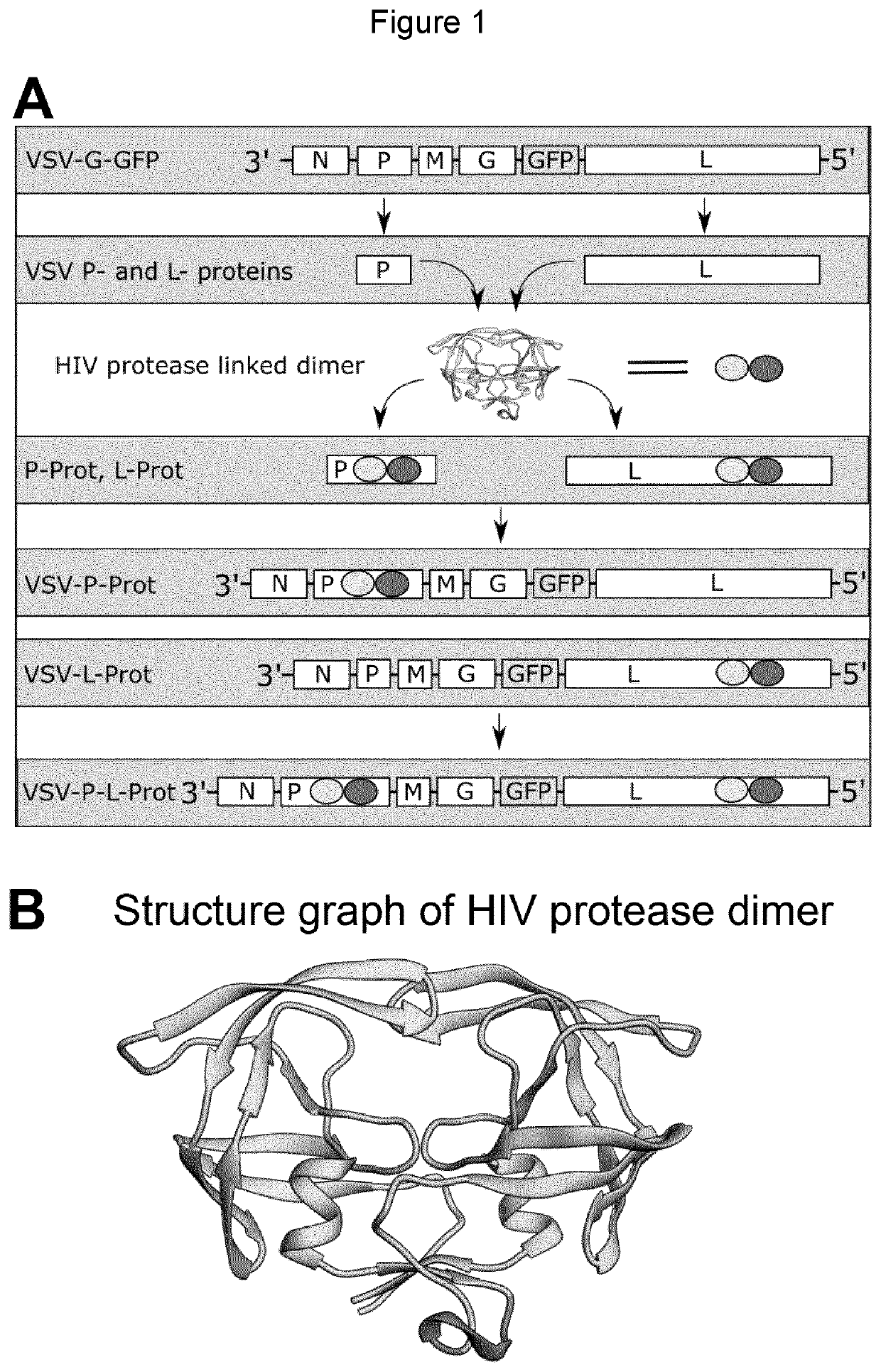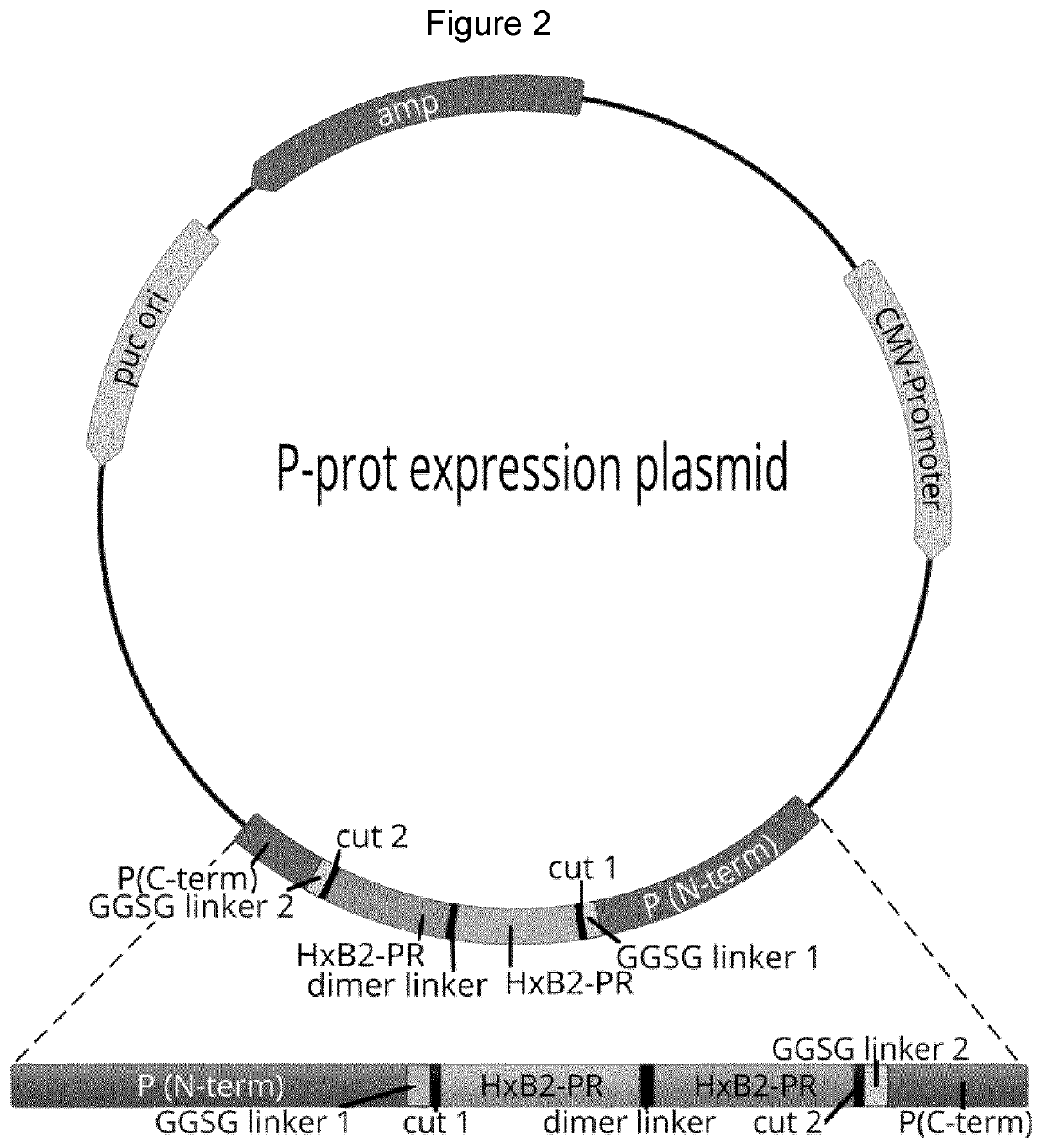Novel Mechanism to Control RNA Virus Replication and Gene Expression
a technology of rna virus and gene expression, applied in the direction of viruses/bacteriophages, drug compositions, peptide sources, etc., can solve the problems of inability to control the transcription or replication activity of viral viruses, the inability of the mechanism to regulate the majority of rna viruses, and the limited clinical development of vsvs
- Summary
- Abstract
- Description
- Claims
- Application Information
AI Technical Summary
Benefits of technology
Problems solved by technology
Method used
Image
Examples
example 1
g a Protease-Regulated ON-Switch, VSV-P-Prot
[0244]To generate a regulatable switch to control activity of RNA viruses, we developed a system that incorporates an autocatalytically active protease sequence into genes essential for VSV gene expression and replication (FIG. 1a). In our first ON-switch construct we introduced an HIV protease dimer into the cofactor of the polymerase of VSV, the P-protein (SEQ ID NO: 1), generating VSV-P-prot. The intramolecular insertion site was previously shown to not affect P-protein function (Das et al., J Virol., 2006, 80(13):6368-6377). The HIV protease function requires dimerization. To facilitate instant post-translational proteolytic activity, the gene insertion construct was designed to harbor two copies of the HIV protease (PR) joined by a flexible linker (FIG. 1b, 2) (Krausslich, PNAS, 1991, 88(8): 3213-3217). Flexible linkers (SEQ ID Nos: 8 and 9) were also applied up- and downstream of the protease construct (SEQ ID NO: 5) resulting in a p...
example 2
t can be Regulated in a Dose-Dependent Fashion and by Various HIV Protease Inhibitors
[0247]To test whether the amprenavir-dependent activity of VSV-P-prot would generalize to other members of the HIV protease inhibitor class, BHK cells were incubated with second generation compounds saquinavir (10 μM) and indinavir (10 μM) followed by infection with VSV-P-prot at an MOI of 0.01. In line with the amprenavir effect, both inhibitors facilitated viral gene expression (GFP signal) and viral replication (plaque formation) (FIG. 7) confirming the universal targetability of the HIV protease-based VSV on-switch system. Also lopinavir (10 μM) and other HIV protease inhibitors were shown to regulate VSV-P-prot (data not shown).
[0248]The amprenavir dose used for virus production and initial studies was chosen according to previously described APV plasma concentrations in patients treated orally with APV (Sadler et al., Antimicrob Agents Chemother, 1999, 43(7):1686-1692). Additionally, a dose re...
example 3
eurotoxicity and Intracranial Spread of VSV-Pprot
[0249]VSV is known for pronounced neurotoxicity in laboratory animals once entered into the CNS space. The VSV glycoprotein shows a strong affinity to neurons and both anterograde and retrograde axonal spread have been described. To address to what extend neurotoxicity of VSV-P-prot is abrogated compared to normal VSV, we employed direct stereotactic injection into the mouse striatum. Intracranial instillation of wildtype-based VSV-dsRed (2×105 TCID50 in 2 μl) led to profound signs of neurotoxicity (FIG. 9A) expressed as hind-limb paralysis, lack of coordination, hunched position, and severe weight drop (FIG. 9C) starting within 2 days post injection. All mice had to be euthanized within 4 days for humane reason (FIG. 9B). In stark contrast, injection of the brain with VSV-P-prot at the same dose resulted in no signs of neurotoxicity. Mice also showed no brain-related adverse signs after intracranial VSV-P-prot injection when treated ...
PUM
| Property | Measurement | Unit |
|---|---|---|
| median volume | aaaaa | aaaaa |
| median volume | aaaaa | aaaaa |
| time | aaaaa | aaaaa |
Abstract
Description
Claims
Application Information
 Login to View More
Login to View More - R&D
- Intellectual Property
- Life Sciences
- Materials
- Tech Scout
- Unparalleled Data Quality
- Higher Quality Content
- 60% Fewer Hallucinations
Browse by: Latest US Patents, China's latest patents, Technical Efficacy Thesaurus, Application Domain, Technology Topic, Popular Technical Reports.
© 2025 PatSnap. All rights reserved.Legal|Privacy policy|Modern Slavery Act Transparency Statement|Sitemap|About US| Contact US: help@patsnap.com



